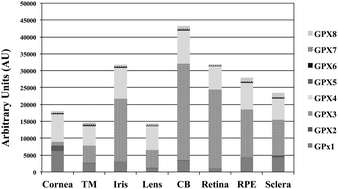当前位置:
X-MOL 学术
›
Metallomics
›
论文详情
Our official English website, www.x-mol.net, welcomes your
feedback! (Note: you will need to create a separate account there.)
Protective effect of selenium supplementation following oxidative stress mediated by glucose on retinal pigment epithelium
Metallomics ( IF 2.9 ) Pub Date : 2017-11-09 00:00:00 , DOI: 10.1039/c7mt00209b Raquel González de Vega 1, 2, 3, 4, 5 , Montserrat García 5, 6, 7, 8, 9 , María Luisa Fernández-Sánchez 1, 2, 3, 4, 5 , Héctor González-Iglesias 5, 6, 7, 8, 9 , Alfredo Sanz-Medel 1, 2, 3, 4, 5
Metallomics ( IF 2.9 ) Pub Date : 2017-11-09 00:00:00 , DOI: 10.1039/c7mt00209b Raquel González de Vega 1, 2, 3, 4, 5 , Montserrat García 5, 6, 7, 8, 9 , María Luisa Fernández-Sánchez 1, 2, 3, 4, 5 , Héctor González-Iglesias 5, 6, 7, 8, 9 , Alfredo Sanz-Medel 1, 2, 3, 4, 5
Affiliation

|
There are many conditions that affect the retina. However, diabetic retinopathy (RD) as a complication of Diabetes Mellitus continues to be the leading cause of blindness in working people globally. Diabetic retinopathy is an ocular complication of diabetes that is caused by the deterioration of the blood vessels that supply the retina, which has the consequence that the vision deteriorates irreversibly. The retina, and specifically the retinal pigment epithelium (RPE) is the only neural tissue that is exposed directly and frequently to light, which favors the oxidation of lipids that become extremely toxic to the cells of the retina. The RPE is a natural barrier playing an important role in the absorption of light and reduction of light scatter within the eye. In addition, the retina is the tissue that proportionally consumes more oxygen, which generates a high production of reactive oxygen species (ROS). The retina is particularly sensitive to hyperglycemia and oxidative stress. The eye tissues are enriched in certain antioxidants in the form of metabolic enzymes or small molecules. Since selenium is essential for regulating the activity of the enzymes involved in protection against oxidative stress, providing selenium to the ocular tissues could be useful for the treatment of different ocular pathologies. Thus, the aim of this study is to investigate the potential efficacy of selenium in human RPE against glucose-induced oxidative stress and its implications for GPx activity. Chromatographic techniques based on HPLC-ICP-MS will be applied in combination with isotope pattern deconvolution (IPD) to study the effects of selenium supplementation and hyperglycemia in an in vitro model of RPE cells.
中文翻译:

葡萄糖介导的氧化应激后硒的补充对视网膜色素上皮的保护作用
有许多情况会影响视网膜。然而,糖尿病性视网膜病(RD)作为糖尿病的并发症仍然是全球劳动者失明的主要原因。糖尿病性视网膜病是糖尿病的眼部并发症,其由供应视网膜的血管退化引起,其结果是视力不可逆转地恶化。视网膜,特别是视网膜色素上皮(RPE)是唯一直接且频繁暴露于光的神经组织,这有助于脂质的氧化,而这些脂质对视网膜的细胞毒性极大。RPE是天然屏障,在吸收光和减少眼内光散射方面起着重要作用。此外,视网膜是按比例消耗更多氧气的组织,会产生大量的活性氧(ROS)。视网膜对高血糖症和氧化应激特别敏感。眼组织富含某些抗氧化剂,它们以代谢酶或小分子的形式存在。由于硒对于调节参与保护抵抗氧化应激的酶的活性是必不可少的,因此向眼组织提供硒可能对治疗不同的眼病有用。因此,本研究的目的是研究硒在人RPE中对抗葡萄糖诱导的氧化应激的潜在功效及其对GPx活性的影响。基于HPLC-ICP-MS的色谱技术将与同位素模式反褶积(IPD)结合使用,以研究硒补充和高血糖对人体的影响。RPE细胞的体外模型。
更新日期:2017-11-09
中文翻译:

葡萄糖介导的氧化应激后硒的补充对视网膜色素上皮的保护作用
有许多情况会影响视网膜。然而,糖尿病性视网膜病(RD)作为糖尿病的并发症仍然是全球劳动者失明的主要原因。糖尿病性视网膜病是糖尿病的眼部并发症,其由供应视网膜的血管退化引起,其结果是视力不可逆转地恶化。视网膜,特别是视网膜色素上皮(RPE)是唯一直接且频繁暴露于光的神经组织,这有助于脂质的氧化,而这些脂质对视网膜的细胞毒性极大。RPE是天然屏障,在吸收光和减少眼内光散射方面起着重要作用。此外,视网膜是按比例消耗更多氧气的组织,会产生大量的活性氧(ROS)。视网膜对高血糖症和氧化应激特别敏感。眼组织富含某些抗氧化剂,它们以代谢酶或小分子的形式存在。由于硒对于调节参与保护抵抗氧化应激的酶的活性是必不可少的,因此向眼组织提供硒可能对治疗不同的眼病有用。因此,本研究的目的是研究硒在人RPE中对抗葡萄糖诱导的氧化应激的潜在功效及其对GPx活性的影响。基于HPLC-ICP-MS的色谱技术将与同位素模式反褶积(IPD)结合使用,以研究硒补充和高血糖对人体的影响。RPE细胞的体外模型。











































 京公网安备 11010802027423号
京公网安备 11010802027423号